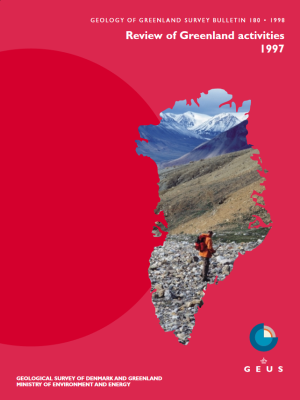A possible new hydrocarbon play, offshore central West Greenland
DOI:
https://doi.org/10.34194/ggub.v180.5082Abstract
The discovery of extensive seeps of crude oil onshore central West Greenland (Christiansen et al. 1992, 1994, 1995, 1996, 1997, 1998, this volume; Christiansen 1993) means that the central West Greenland area is now prospective for hydrocarbons in its own right. Analysis of the oils (Bojesen-Koefoed et al. in press) shows that their source rocks are probably nearby and, because the oils are found within the Lower Tertiary basalts, the source rocks must be below the basalts. It is therefore possible that in the offshore area oil could have migrated through the basalts and be trapped in overlying sediments. In the offshore area to the west of Disko and Nuussuaq (Fig. 1), Whittaker (1995, 1996) interpreted a few multichannel seismic lines acquired in 1990, together with some seismic data acquired by industry in the 1970s. He described a number of large rotated fault-blocks containing structural closures at top basalt level that could indicate leads capable of trapping hydrocarbons. In order to investigate Whittaker’s (1995, 1996) interpretation, in 1995 the Geological Survey of Greenland acquired 1960 km new multichannel seismic data (Fig. 1) using funds provided by the Government of Greenland, Minerals Office (now Bureau of Minerals and Petroleum) and the Danish State through the Mineral Resources Administration for Greenland. The data were acquired using the Danish Naval vessel Thetis which had been adapted to accommodate seismic equipment. The data acquired in 1995 have been integrated with the older data and an interpretation has been carried out of the structure of the top basalt reflection. This work shows a fault pattern in general agreement with that of Whittaker (1995, 1996), although there are differences in detail. In particular the largest structural closure reported by Whittaker (1995) has not been confirmed. Furthermore, one of Whittaker’s (1995) smaller leads seems to be larger than he had interpreted and may be associated with a DHI (direct hydrocarbon indicator) in the form of a ‘bright spot’.
Downloads
Published
Issue
Section
License
This article is distributed under a CC-BY 4.0 licence, permitting free redistribution and reproduction for any purpose, even commercial, provided proper citation of the original work. Author(s) retain copyright over the article contents.


